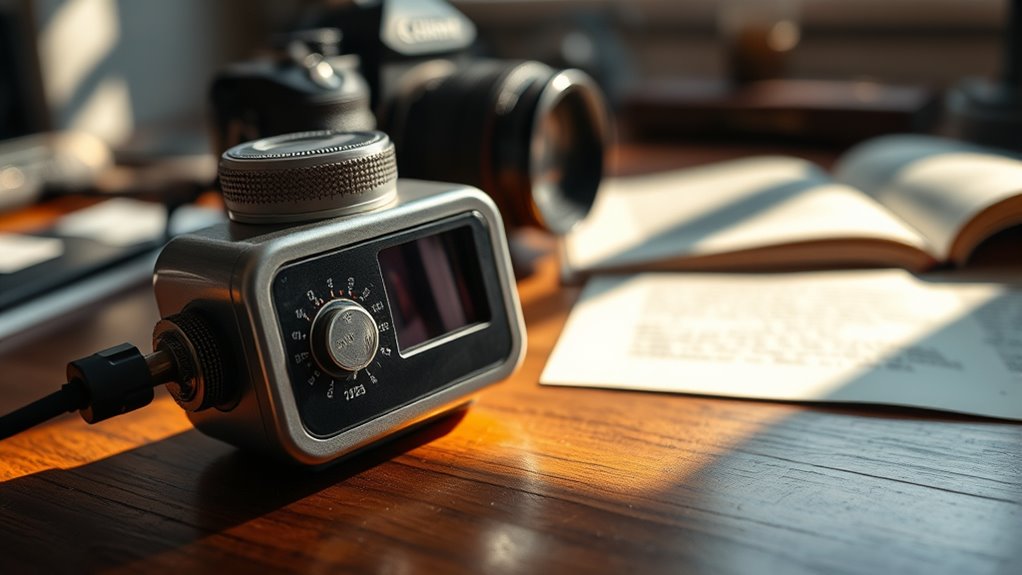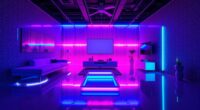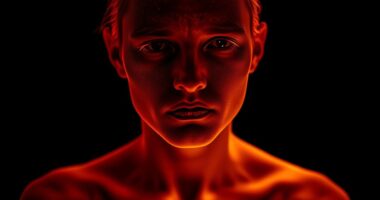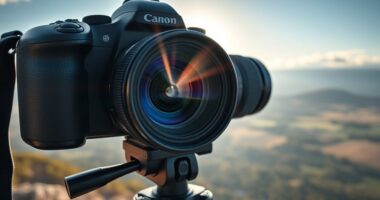In 2025, hand-held light meters remain highly relevant for photographers and lighting professionals, offering unmatched accuracy and consistency that digital devices and smartphones often can’t provide. They measure incident or reflected light directly, making them essential in complex or high-contrast scenes. While digital tools have improved, dedicated meters still deliver reliable, professional results. If you’d like to discover how these tools continue to impact photography today, there’s more to explore below.
Key Takeaways
- Hand-held meters offer unmatched accuracy in complex lighting scenarios, maintaining their value for professional photography in 2025.
- Modern models combine digital features like Bluetooth connectivity with traditional sensors, enhancing usability and data management.
- Smartphone-based light measurement tools are accessible but generally less precise, making dedicated meters still relevant for critical work.
- Despite digital and mobile alternatives, hand-held meters remain essential for consistent, objective exposure readings.
- They continue to serve as reliable, tactile tools in professional environments, complementing digital solutions rather than replacing them.
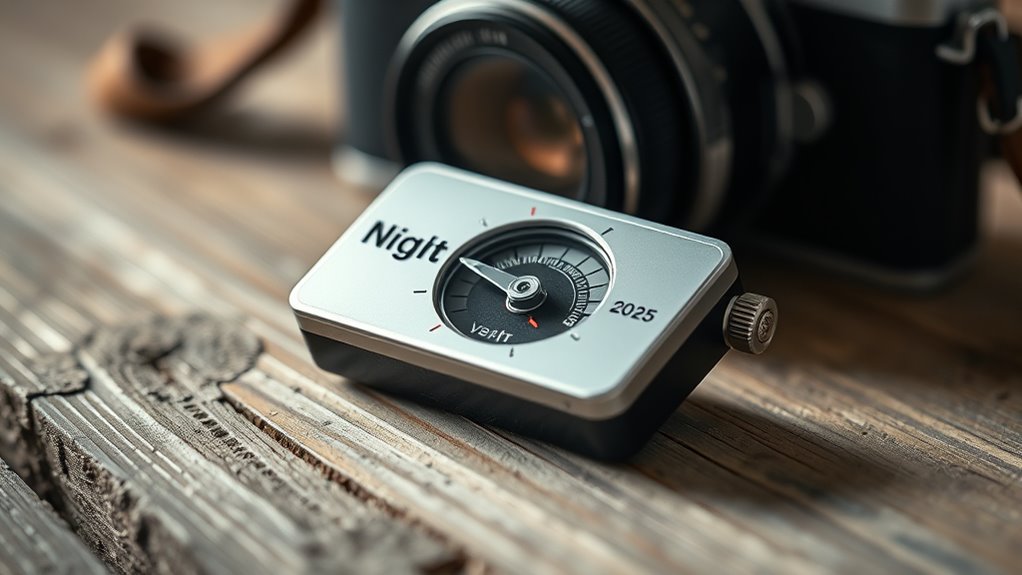
Have you ever wondered how photographers determine the perfect exposure? It’s a pivotal step that influences the quality of every shot, and historically, hand-held light meters have been the go-to tools for achieving that perfect balance of light. Today, though, the landscape has shifted. Digital alternatives, especially smartphone integration, have made exposure measurement more accessible and convenient. But does that mean traditional hand-held light meters have become obsolete in 2025? Not necessarily.
While smartphones now come equipped with sophisticated camera apps and light metering features, dedicated hand-held light meters still offer a level of precision and reliability that many digital alternatives can’t fully match. Smartphone sensors can be influenced by multiple factors, such as reflections, lens quality, and the device’s built-in processing, which may lead to less accurate readings in complex lighting situations. Hand-held meters, on the other hand, use a physical sensor to measure incident or reflected light directly, providing more consistent and objective data. This precision becomes especially important in professional settings like studio photography, landscape shoots with tricky lighting, or high-contrast scenes where accuracy can make or break the final image.
Dedicated light meters still provide unmatched precision for professional and complex lighting situations.
Moreover, the integration of digital technology doesn’t have to mean abandoning traditional tools altogether. In fact, many modern hand-held light meters now incorporate digital features, making them more user-friendly and adaptable. Some models even sync with smartphones via Bluetooth or Wi-Fi, allowing you to transfer data quickly or view measurements on a larger screen. This hybrid approach combines the best of both worlds: the tactile reliability of a dedicated device and the convenience of digital connectivity. It’s an ideal solution for photographers who want precise light measurement without sacrificing the ease of modern technology.
However, the rise of smartphone-based tools has certainly democratized exposure measurement. You no longer need to carry a bulky meter if you’re an amateur or casual shooter — your phone can often do the job, especially in well-lit environments. But for those who demand utmost accuracy, especially in controlled studio settings or professional shoots, hand-held light meters still hold a valuable edge. They provide a level of confidence that digital alternatives, with their inherent limitations, might not guarantee.
In 2025, the relevance of hand-held light meters isn’t about replacing digital options but about understanding their strengths and knowing when to rely on them. Whether you’re integrating digital features into traditional meters or using them as standalone tools, they remain a essential part of a photographer’s toolkit. They serve as a reminder that, despite technological advances, sometimes the most straightforward, dedicated tools still deliver the best results.
Frequently Asked Questions
How Do Digital Light Meters Compare to Smartphone Apps in Accuracy?
Digital light meters generally offer more accurate readings than smartphone apps, especially when they have properly calibrated sensors. You can depend on their precise sensor calibration for consistent results. Smartphone apps often integrate with device sensors but may lack the same level of accuracy due to hardware limitations. While apps are convenient, investing in a dedicated digital light meter ensures better accuracy for critical lighting measurements.
Are Traditional Hand-Held Light Meters Compatible With Modern Digital Cameras?
You’ll find that traditional hand-held light meters are generally compatible with modern digital cameras, but compatibility issues can arise due to digital integration features. Some meters may lack specific connectors or settings for digital cameras, so check compatibility before purchasing. Despite this, many photographers still prefer hand-held meters for their accuracy and reliability, especially when precise exposure measurements are essential, even as digital technology continues to evolve.
What Is the Average Lifespan of a Typical Hand-Held Light Meter?
A typical hand-held light meter usually lasts around 10 to 15 years, but this depends on battery longevity and calibration frequency. You should replace the batteries regularly to keep it functioning properly, and calibrate it every 1-2 years to maintain accuracy. Proper care extends its lifespan, ensuring you get reliable readings over the years. With good maintenance, your meter can serve you well for a decade or more.
Can Hand-Held Light Meters Measure Different Light Qualities Besides Visible Light?
Imagine opening new worlds with your tools—that’s what spectral sensitivity does for you. Hand-held light meters can measure more than just visible light; they explore different light qualities across the spectrum. With advanced sensors, you can achieve precise light spectrum measurement, capturing ultraviolet or infrared light. So, yes, these meters aren’t just limited to what the eye sees—they expand your creative and technical horizons beyond visible boundaries.
Are There Any Affordable Models Suitable for Amateur Photographers?
If you’re looking for affordable options, there are plenty of budget options and beginner-friendly models that suit amateurs. You’ll find meters that are easy to operate and won’t break the bank, yet still provide reliable light measurements. These models help you learn about exposure and lighting without overwhelming complexity. So, you can confidently improve your photography skills while sticking to a budget with these accessible hand-held light meters.
Conclusion
While technology continues to evolve, hand-held light meters still hold a subtle charm for those who appreciate their tactile precision. Though modern devices offer convenience, these timeless tools gently remind us of the art behind perfect exposure. In a world rushing toward digital, they quietly preserve a tradition of craftsmanship, subtly enriching your photographic journey. Embracing them, even in 2025, allows you to navigate light with a refined touch that’s hard to replicate.
